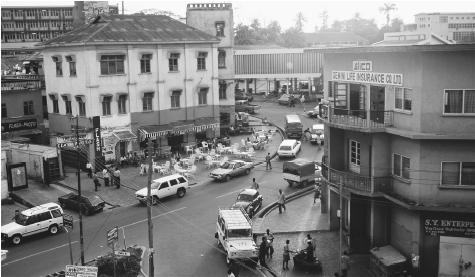

References
Relevant Links
Media Links
Ghana History Population Politics
SOCIAL STRATIFICATION
Classes and Castes. Ghana's stratification system follows both precolonial and modern patterns. Most traditional kingdoms were divided into three hereditary classes: royals, commoners, and slaves. The royals maintained exclusive rights to fill the central offices of king and, for Akan groups, queen mother. Incumbents acquired political and economic privileges, based on state control over foreign trade. Unlike European nobilities, however, special status was given only to office-holders and not their extended families, and no special monopoly over land
A busy street in Kumasi. Ghana's urban centers are dominated by European-style buildings, a reminder of its British colonizers.
was present. Moreover, royals regularly married commoners, a consequence of a rule of lineage out-marriage. Freemen held a wide variety of rights, including unhampered control over farm land and control over subordinate political positions. Slavery occurred mainly as domestic bondage, in which a slave could command some rights, including the ability to marry a nonslave and acquire property. Slaves were also used by the state for menial work such as porterage and mining.
Slavery is no longer significant. Traditional royalties are still recognized but have been superseded by Westernized elites. Contemporary stratification is based on education and, to a lesser degree, wealth, both of which have led to significant social mobility since independence. Marked wealth differences have also emerged, but have been moderated by extended family support obligations and the communal rights that most Ghanaians hold in land. Northerners, however, form a noticeable underclass, occupying low status jobs. Bukinabe and Togolese are especially disadvantaged because, as foreigners, they cannot acquire land.
Symbols of Social Stratification. In traditional practice, kings and other hereditary officials marked their status through the use of regalia, such as umbrellas and staves, and the exclusive right to wear expensive clothing, such as kente cloth, and to consume and distribute special imported goods. In modern times, expenditure on Western consumer items has become the dominant status marker. Clothing, both expensive Western and traditional items, is an important symbol of education and wealth. Luxury cars are also significant—a Mercedes-Benz is the most dominant marker of high rank. Status must also be demonstrated in public display, especially in lavish funerals that acclaim both the deceased and their descendants.
—BRIAN SCHWIMMER
Ghana Menu
ORIENTATION
HISTORY AND ETHNIC RELATIONS
URBANISM, ARCHITECTURE, AND THE USE OF SPACE
FOOD AND ECONOMY
SOCIAL STRATIFICATION
POLITICAL LIFE
SOCIAL WELFARE AND CHANGE PROGRAMS
NONGOVERNMENTAL ORGANIZATIONS AND OTHER ASSOCIATIONS
GENDER ROLES AND STATUSES
MARRIAGE, FAMILY, AND KINSHIP
SOCIALIZATION
ETIQUETTE
RELIGION
MEDICINE AND HEALTH CARE
SECULAR CELEBRATIONS
THE ARTS AND THE HUMANITIES
THE STATE OF THE PHYSICAL AND SOCIAL SCIENCES



